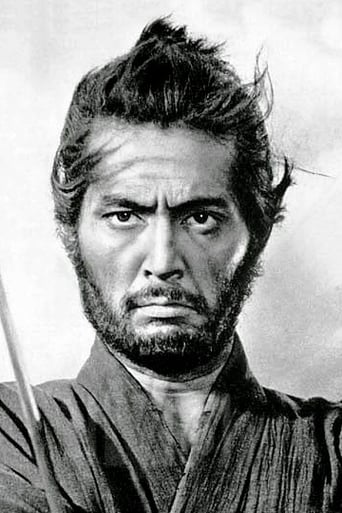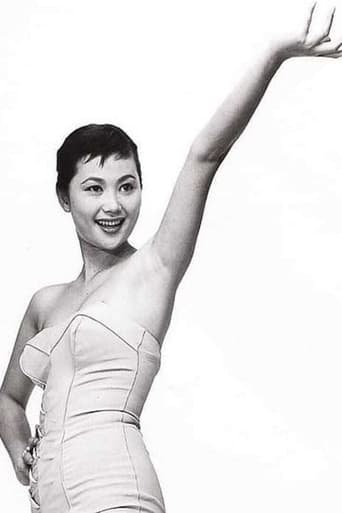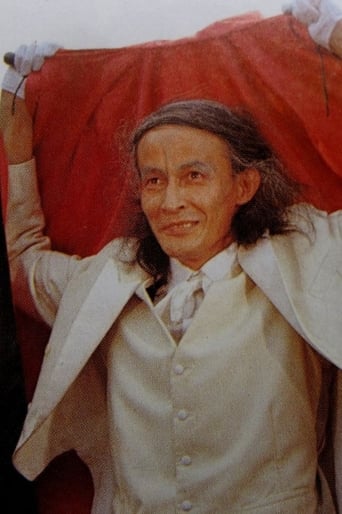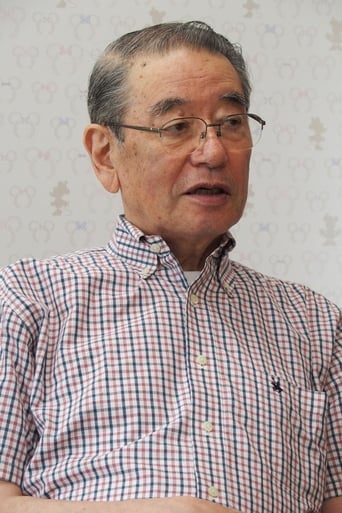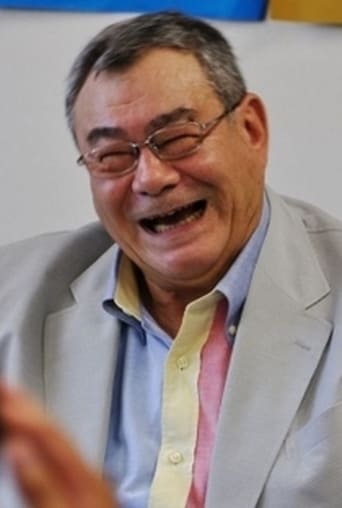Ensofter
Overrated and overhyped
Megamind
To all those who have watched it: I hope you enjoyed it as much as I do.
Tobias Burrows
It's easily one of the freshest, sharpest and most enjoyable films of this year.
Juana
what a terribly boring film. I'm sorry but this is absolutely not deserving of best picture and will be forgotten quickly. Entertaining and engaging cinema? No. Nothing performances with flat faces and mistaking silence for subtlety.
superville
This film has a definite European feel to it (French comedy with a touch of early Almodovar), only it was made in Japan in mid sixties.The plot is simple and crazy at the same time. The main character Shinji (Tatsuya Nakadai) is singled out for extermination by a mad, Nazi inspired scientist (Eisei Amamoto)who sets up numerous traps and sends countless assassins in all guises Shinji's way. In the process Shinji undergoes a transformation from a shabby, socially awkward university lecturer to a sly, dashing agent 007 type only to return to his nerdy self at the end of the film. Which made me wonder: was it all a dream? I guess that's part of the film's premise.Tatsuya Nakadai shows his comic side this time and is priceless as the hapless Shinji turned into James Bond and back. The set of Amamoto's lunatic asylum seems to be a jab at Teshigahara's pretentious aesthetics. The film is well paced, inventive and visually stimulating. If you are willing to leave aside logic and simply take the ride,you are in for a rewarding cinematic experience.
chaos-rampant
This is a comedy first and foremost in the farcical European sense of the term. Tatsuya Nakadai's character is a naive meek teacher with a skin rash in his feet and a Renault Deuxceveau that farts smoke like Mr. Hulot's car in Jacques Tati's movie and for some inexplicable reason he becomes the target of an organisation called the "Japanese Population Control Agency" which sends wave after wave of quirky assassins his way. This group is led by the halfmad director of an insane asylum who is a fanatic of war and murder, an ex-Nazi who switches between Japanese and German for most of the movie and wears black gloved hands and a grotesque smile. In some ways all this recalls Peter Sellers' character from DR. STRANGELOVE and the movie has some of that crackerjack/gonzo ambiance.It's all a bit inconsequential plotwise and the movie never develops the grim gravitas of Okamoto's better works because it must sprawl across a dozen different locations, from Tokyo's subways to a holiday resort in Mt. Fuji, and it must pause for Nakadai and his henchman to be shelled by the army before it can move on to its destination. A Spanish knife standoff between Nakadai (who in the process of the movie is turned from naive happy-go-lucky teacher to suave and sly, a Japanese version of Alain Delon which is oddly fitting for the kind of movie Age of Assassins is trying to be) and mad ex-Nazi scientist in a hall made up of brilliant art nouveau decorations and a dazzling whiteness that looks like something out of a Hiroshi Teshigahara movie.This is even less of a Japanese New Wave film than Okamoto's subsequent THE HUMAN BULLET which marginally touched the outskirts of that niche occupied in the late 60's by the likes of Shohei Imamura and Nagisa Oshima. It does share, however, a similarity in the avantgarde sets, stylish setpieces, and general ironic absurdity, with Seijun Suzuki's idiosynchratic early 60's films leading up to BRANDED TO KILL, yet from the Pink Pantherish animated opening credits to the broad, sometimes goofy, humor, it is also closer to the Eurospy extravanzas of the 60's than the typical Japanese noir made in the early years of the decade in studios like Nikkatsu and Shintoho. In the same time it's a sendup of all that with typical for Okamoto jabs at militarism and war.Everyone in the movie is looking for a gem called the Tear of Cleopatra but it's a Hitchcockian McGuffin, an opportunity for Okamoto to take us on a tour through a series of elaborate images whether they be footage of Hitler rearprojected through a car window or the severed head of a doll used by a hypnotist as an illuminated pendulum. It doesn't amount to much in the end but it's visually inventive and fun to watch.
Steven_Harrison
The film begins with exposition as a lunatic asylum "mad scientist" ex-Nazi played by Amamoto Eisei (he and his pals switch back and forth between menacing Japanese and scary German the whole film) discusses how a massive diamond was lost and a young Japanese (Nakadai Tatsuya) has it in his possession. A league of assassins make comedic attempts at Nakadai's life (along with a girl, Dan Reiko, Yuriko from Ozu's The End of Summer and a goofy pal) which are all thwarted, naturally, since even playing a little bit of a "dweeb", Nakadai is still graced with luck and a certain charisma (a natural fighting ability). Turns out the diamond is a stolen Nazi item which was placed in Nakadai's body when he was eight.Okamoto used the same cinematographer for this as Kill!, so it has that same crisp detail, but it's a bit more high contrast (the black and white world of assassinations, I suppose.) The score is almost inappropriately "emotional" at times, but enhances the odd factor. The action is believable, in a "chase film" sort of way, but the real greatness of Epoch of Murder and Madness is in the comedy. Not too broad (though Nakadai's small-enough-to-pedal-with-your-feet car, which emits burps and farts as it runs, runs counter to that claim) and like most of his films anti-authority and anti-war, a fair bit of cynicism and a love for the details of human nature seem to be the ideas behind it. A bit of his earlier The Elegant Mr. Everyman can be seen in the way Nakadai uses his voice as a blunt instrument of humor, streamlining dialogue in a way that almost sounds like narration. The cynical soldier, with aims at the ridiculousness of war, is then best exemplified in his Nikudan, or The Human Bullet (my favorite of his films, and one which Isolde Standish's Myth and Masculinity in Japanese Film does a thorough job of explicating), where Nakadai's Epoch Of... character, Kikyo Shinji seems to be transposed into the Special Attack Forces. Properly enough, Nakadai narrated Human Bullet and the evil as hell Amamoto Eisei plays the main character's father (i.e. the villain). Worth noting that the "main character" of Human Bullet, played by Terada Minori, goes unnamed.Someone needs to bring this, and the rest of Okamoto's sixties work, to DVD badly.
